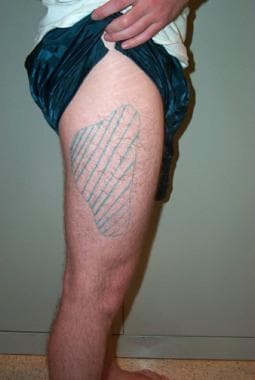Background
A painful mononeuropathy of the lateral femoral cutaneous nerve (LFCN), meralgia paresthetica is commonly due to focal entrapment of this nerve as it passes through the inguinal ligament. Rarely, it has other etiologies such as direct trauma, stretch injury, or ischemia. It typically occurs in isolation. The clinical history and examination is usually sufficient for making the diagnosis. However, the diagnosis can be confirmed by nerve conduction studies. Treatment is usually supportive. The LFCN is responsible for the sensation of the anterolateral thigh. It is a purely sensory nerve and has no motor component. [1]
Pathophysiology
Reviewing the anatomy of the lateral femoral cutaneous nerve (LFCN) is essential for understanding the mechanism of its injury (see the images below). The LFCN originates directly from the lumbar plexus and has root innervation from L2-3. The nerve runs through the pelvis along the lateral border of the psoas muscle to the lateral part of the inguinal ligament. Here, it passes to the thigh through a tunnel formed by the lateral attachment of the inguinal ligament and the anterior superior iliac spine. The crossover into the thigh is the most common site of entrapment. The crossover typically occurs 1 cm medial to the anterior superior iliac spine; however, regional variations are common. [2]
Epidemiology
Frequency
The incidence of meralgia paresthetica in the general population has been reported to be 4.3 per 10,000 person years.
In people with diabetes mellitus, an incidence of 247 per 100,000 patient years has been reported. [3]
Demographics
There is no known racial predilection or gender proclivity in meralgia paresthetica.
Lateral femoral cutaneous neuropathies are most common during middle age. However, they have been reported in all age groups.
Prognosis
The paresthesias typically resolve slowly over time, but the numbness in the distribution of the lateral femoral cutaneous nerve (LFCN) may persist.
A literature review of patients with meralgia paresthetica who were treated with neurectomy, neurolysis, or injection found the incidence of complete pain relief to be 85%, 63%, and 22%, respectively. The incidence of treatment complications ranged from 0% to 5%, being statistically comparable between the three procedures. [4]
-
Anatomy of the lateral femoral cutaneous nerve.
-
Sensory distribution of the lateral femoral cutaneous nerve.



